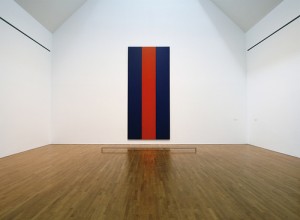Canada’s biggest art scandal
Ten years later the embers of Canada’s biggest art scandal are still burning.
Within 72 hours of the National Gallery of Canada reporting that it had purchased Voice of Fire, a huge abstract painting by American artist Barnett Newman for $1.76 million, the media, the public and the government went ballistic.
The two-month furore that raged in the media and the House of Commons in March 1990 was Canada’s biggest art controversy.
A 1996 book Voices of Fire: Art, Rage, Power and the State, edited by Bruce Barber, Serge Guilbaut and John O’Brian, chronicled the fiasco and tried to make sense of it.
It all began March 7, 1990.
“We rarely have a chance in today’s over-heated art market to purchase works of the scale and historical significance of Voice of Fire,” the gallery’s director, Shirley Thomson, said.
Voice of Fire, a 5.4-metre-high by 2.4-metre-wide canvas with three stripes, was originally commissioned by the American government for an exhibition of U.S. contemporary art at Expo ’67 in Montreal.
The public had a different view when Global News took to the streets with a camera and mic.
It was compared to “a ribbon of a military medal,” a “flag in some country somewhere,” something “my son’ll do in daycare.” Some said they wouldn’t pay $1 for it. Some thought it belonged in the garbage.
Other smarty-pants thought they could do better.
The first of many Voice of Fire parodies, Echo of Fire, by a Victoria, B.C. duo, was advertised as a steal in the Victoria Times-Colonist at $3.2 million.
Political cartoonists satirized it, although many didn’t pay enough attention to get the sequence and colouring of the stripes right.
Letters to the editor poured in across the country.
“Brian Mulroney can raise his popularity by five to 10 percentage points by simply firing whoever is responsible for the purchase of Voice of Fire,” one man wrote to the Toronto Star.
“P.T. Barnum was certainly right when he said ‘There’s one born every minute.’ But how come so many of them get to spend our tax dollars?” a woman wrote in the Saskatoon Star-Phoenix.
Manitoba MP Felix Holtmann, chair of the House of Commons committee on communications and culture, waded into the debate on a Winnipeg radio talk show.
“It looks like two cans of paint and two rollers and about 10 minutes would do the trick.”
The committee called the gallery directors before it and even contemplated making them rescind the offer until it found out the sale was a done deal.
Brydon Smith, assistant gallery director at the time and a Voice of Fire fan since he first saw it at Expo ’67, defended the work against critics and those who said the gallery should have bought Canadian.
He said such thinking would mean the National Gallery should sell all its Picassos, Van Goghs and Degas. He said Newman was a great influence on contemporary Canadian artists like Guido Molinar, Robert Murray and Claude Tousignant.
Smith distributed a leaflet to explain the significance of the work when Voice of Fire was first hung on the National Gallery’s new wall.
“As we struggle nationally and internationally with out individual and collective identities, it is a timely reminder for each of us what it is to be independent and free of oppression while at the same time part of a larger world.”
Voice of Fire still raised people’s hackles said Carol Payne, assistant
professor of contemporary art history at Carleton University. People flock to the gallery to grumble or shake their heads about the purchase.
“This perception of the public reinforces the notion that there is a gap between artists’ work and the public’s perception.”



waw, is amazing.